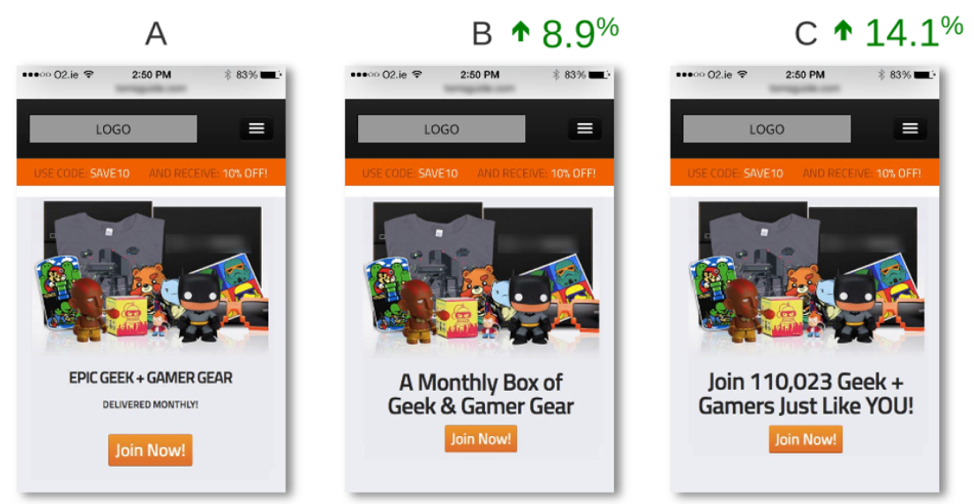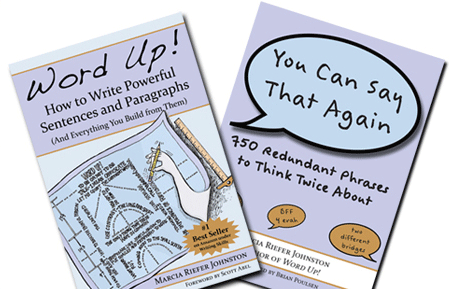This article—originally entitled “Words That Convert: Test, Learn, Repeat”—first appeared in slightly different form on March 19, 2018, on the Content Marketing Institute blog. Even if you’re not a marketer, if you write for the web and you sometimes ask people to click something, you may be surprised at the impact that even slight changes in wording can have on your visitors actions—and not always in the way you’d predict.
One of the most effective ways to get the results you’re looking for in your web-based writing is to test and tweak your words. So says Chris Goward, author of the book You Should Test That! And he can prove it. Chris has worked with companies like Google, IBM, Magento, and 1-800 Flowers. He has seen the difference that rewording can make.
Chris shared his methods at Content Marketing World, where he presented the talk The Ultimate Session on Words That Convert (How to Find ’em and How to Use ’em)—Mobile, E-Commerce, and More.
Results: A Few Examples
If it sounds like a lot of bother to test and tweak your words, consider the potential payoff. Here are some examples of conversion-rate boosts that Chris’s team has seen simply from testing and tweaking words:
- 6% increase in e-commerce transactions for luxury homeware goods retailer Annie Selke
- 6% increase in qualified leads for Magento Enterprise digital-commerce solution
- $1 million increase in revenue per month for BuildDirect.com
Who wouldn’t love results like that? But … how do you test? Which tweaks pay off?
Question “Common Knowledge” about Words That Convert (or Don’t)
While it’s tempting to follow easy advice about words to use and words to avoid, you get the best results when you question what “everybody knows” about words that convert (or don’t).
In case you wonder what marketers mean by “convert”—a term that they just may use more often than preachers do—I’ll quote Andy Crestodina in his Content Marketing World talk. When people convert, “they turn from one thing into another.” In marketing, people turn from visitor to lead, for example, or to subscriber or donor or event registrant.
Do your own testing, Chris says, and you might be surprised at the words that convert the most people.
For example, you’ve probably heard that the word “submit” on a button doesn’t convert well. No one wants to be told to submit, right? Not necessarily. Chris’s team discovered that this “common knowledge” isn’t always true after they experimented with three text alternatives:
- “Submit”
- “Become a maven”
- “I want in”
They hypothesized that “Become a maven” would lift orders because it would make people feel that they belong by leveraging a term used frequently in this client’s customer community. And they hypothesized that “I want in” would lift orders because it conveys a sense of urgency.
To the team’s surprise, “Submit” outperformed the other two alternatives.

The point isn’t that your buttons should say “Submit.” The point is to avoid making assumptions. Test for yourself. What works (or doesn’t) in one context doesn’t necessarily work (or fail to work) in another.
Here are some more words that Chris says you can’t make assumptions about. You may have heard that words such as “new,” “free,” “instantly,” “because,” “you,” “your,” and “should” automatically give your content a boost.

“These words may work in one context and not in another,” Chris says. (I have to smile at the first two words of Chris’s book title: You Should Test That! Apparently the “you should” tested well in that context.)
Want to use words that convert on your website? Don’t trust “common knowledge.” And take Chris’s advice: “Experiment. Experiment again. Testing is never complete.”
Understand Why People Prefer Your High-Converting Words
The words that convert best may tell you something about what motivates the people in your test audience. From those high-converting words, Chris suggests that you infer something about people’s motivations. You can then refine other text accordingly and test to see whether those additional edits boost conversion even more.
Chris’s team ran the following experiment for a client that provides a monthly subscription box for gamers. The goal was to have more people subscribe to the company’s monthly shipments of stickers, T-shirts, and all kinds of stuff that gamers apparently love.
First, the team tested three alternatives for the button text:
- “Subscribe”
- “Join Now!”
- “Select Your Plan”
Care to guess which phrase came out ahead?
The winner was “Join Now!” which outperformed “Subscribe” by 0.6%.

Instead of stopping, satisfied with a 0.6% lift, the team did another test based on a hunch that the test audience’s preference for “Join Now!” indicated an inclination to be motivated by sociability. This time, the team used “Join Now!” in all the buttons and varied the phrase above the button:
- “EPIC GEEK + GAMER GEAR DELIVERED MONTHLY!”
- “A Monthly Box of Geek & Gamer Gear”
- “Join 110,023 Geek + Gamers Just Like YOU!”

Chris’s team attributes at least part of the 14.1% conversion increase in the third example to the sociable language used in the line above the button. The sociability of this text aligns with the sociability of the text used in the button.
You could argue that the larger font in both the B and C versions has something to do with the boost in conversions. Still, Chris’s point makes sense: if you can infer the reason that a group of people prefer the text on one button to the text on another, you’re wise to edit the text beyond the button so that the whole page appeals to that audience’s motivational leaning.
Learn Why Those Words Motivate Your Audience
How do you determine what motivates a group of people to click one phrase more than another? One way to answer that question is to use the Limbic® model, which Natasha Wahid, one of Chris’s colleagues, describes as “one of the world’s best-founded approaches for understanding the emotional systems of your customers.”
The word “limbic” refers to the part of the brain responsible for emotions, motivation, and behavior.

Since many of our decisions are made unconsciously and are based on emotion, as Natasha goes on to say, it only makes sense that we can increase conversions by tapping in to the emotional underpinnings of people’s choices and editing text accordingly.
Chris and his team use the Limbic model—which is based on findings across neuroanatomy, evolutionary biology, neurochemistry, and psychology—to assess people’s emotions and motivations. These emotional values are then recorded on the Limbic map.
To create the Limbic map, the researchers evaluated various mental models and discovered 60-some emotion-based motivations for people to convert. The terms in the Limbic map fall into three categories: adventure/thrill, discipline/control, and fantasy/pleasure.

Let’s go back to the “Join now!” example above. Based on the results of tinkering with that one phrase, Chris’s team suspected that for this audience—gamers—a big motivational factor was sociability (highlighted in orange inside the “fantasy/pleasure” section of the Limbic map). The team edited another key phrase accordingly, and the conversion rate jumped.
While it strikes me as simplistic to focus on one type of motivation for a whole audience, I see value in what Chris proposes. Audiences are audiences because they have things in common. If rewording one phrase results in more of your audience doing what you want them to do, you might as well get curious as to why. Make a guess! If you’re right about why more people took action in that one case, you stand to gain by applying your insight more broadly.
And if you’re wrong—that is, if your follow-on edits result in fewer people taking the desired action—no big deal. Change the text back. That’s the beauty of testing: you make guesses along the way, and then you make choices based on data.
(Are you wondering how, exactly, you’d conduct the kind of testing Chris talks about? I can’t help you there. For one thing, the topic of testing is huge. For another, I’m no expert on testing. Besides, I have to leave you something to explore on your own.)
Conclusion
Although there’s no list of words guaranteed to get your website visitors to take some action you want them to take, you can bet that certain words appeal more than others. To discover those words, follow Chris’s approach:
- Test various phrasings of a call to action, and see which produces the best results.
- Identify possible emotional triggers behind that phrasing, and align more text with them.
- Test again.
Do you ever test the wording of your online text? If so, please share an example or two in a comment below!
The original Content Marketing Institute version of this article was selected as a winner in the Content Marketing category in the 2018 B2B Marketing Zone MVP Awards.




I’m glad somebody is testing this kind of thing. I have often looked at a web site and wished they had a bunch of us in the room to offer suggestions on how wording could be improved. For me (the user) it’s less about appeal than about clarity, but the issue is the same — they used wording that made sense to them but not necessarily to their customers.
I’m with you, Wendy. Sometimes people are plenty motivated to take action and just need a clear path to do so.
If I’m ever looking for a test volunteer, you’re at the top of my list!